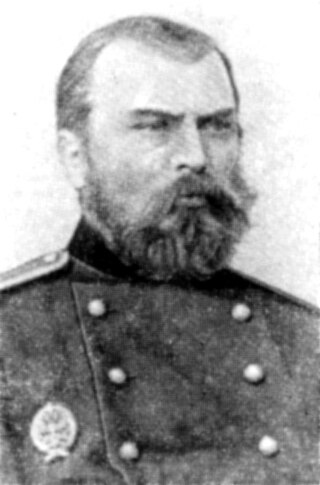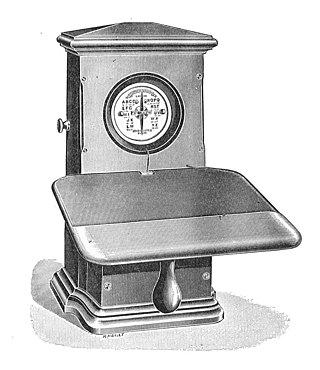
Electrical telegraphs were point-to-point text messaging systems, primarily used from the 1840s until the late 20th century. It was the first electrical telecommunications system and the most widely used of a number of early messaging systems called telegraphs, that were devised to communicate text messages more quickly than physical transportation. Electrical telegraphy can be considered to be the first example of electrical engineering.

Ernst Werner Siemens was a German electrical engineer, inventor and industrialist. Siemens's name has been adopted as the SI unit of electrical conductance, the siemens. He founded the electrical and telecommunications conglomerate Siemens and invented the electric tram, trolley bus, electric locomotive and electric elevator.

Sir Carl Wilhelm Siemens, anglicised to Charles William Siemens, was a German-British electrical engineer and businessman.

Peter Carl Fabergé, also Karl Gustavovich Fabergé was a Russian jeweller best known for the famous Fabergé eggs made in the style of genuine Easter eggs, but using precious metals and gemstones rather than more mundane materials. He was one of the sons of the founder of the famous jewelry legacy House of Fabergé.

Siemens AG is a German multinational technology conglomerate. Its operations encompass automation and digitalization in the process and manufacturing industries, intelligent infrastructure for buildings and distributed energy systems, rail transport solutions, as well as health technology and digital healthcare services. Siemens is the largest industrial manufacturing company in Europe, and holds the position of global market leader in industrial automation and industrial software.

An electric locomotive is a locomotive powered by electricity from overhead lines, a third rail or on-board energy storage such as a battery or a supercapacitor. Locomotives with on-board fuelled prime movers, such as diesel engines or gas turbines, are classed as diesel-electric or gas turbine-electric and not as electric locomotives, because the electric generator/motor combination serves only as a power transmission system.

Francesco Bartolomeo Rastrelli was an Italian architect who worked mainly in Russia. He developed an easily recognizable style of Late Baroque, both sumptuous and majestic. His major works, including the Winter Palace in Saint Petersburg and the Catherine Palace in Tsarskoye Selo, are famed for extravagant luxury and opulence of decoration.

Baron Pavel Lvovitch Schilling (1786–1837), also known as Paul Schilling, was a Russian military officer and diplomat of Baltic German origin. The majority of his career was spent working for the imperial Russian Ministry of Foreign Affairs as a language officer at the Russian embassy in Munich. As a military officer, he took part in the War of the Sixth Coalition against Napoleon. In his later career, he was transferred to the Asian department of the ministry and undertook a tour of Mongolia to collect ancient manuscripts.

Konstantin von Benckendorff was a Baltic German general and diplomat.

Carl Heinrich von Siemens was a German entrepreneur.

Siemens & Halske AG was a German electrical engineering company that later became part of Siemens.

Fyodor Apollonovich Pirotsky, or Fedir Apollonovych Pirotskyy was a Russian engineer of Ukrainian ancestry, inventor of the world's first railway electrification system and electric tram While the commercialization of his inventions in the Russian Empire was relatively slow, Pirotsky is known to have met with Carl Heinrich von Siemens and influenced Siemens' eventual introduction of the first regular electric tram line.

The Sapsan is a Russian gauge high speed electric express train. The train is a Siemens Velaro model, which in turn is based on the ICE 3M/F high-speed trains manufactured by Siemens for the German Deutsche Bahn (DB), known as the Siemens Velaro RUS.

The Tsarskoye Selo Railway was the first public railway line in the Russian Empire. It ran for 27 km (17 mi) from Saint Petersburg to Pavlovsk through the nearby (4 km) Tsarskoye Selo. Construction began in May 1836, and the first test trips were carried out the same year between Tsarskoye Selo and Pavlovsk, using horse-drawn trains. The line was officially opened on 30 October 1837, when an 8-carriage train was hauled by a steam locomotive between Saint Petersburg and Tsarskoye Selo. Until the construction of the Moscow – Saint Petersburg Railway in 1851, it was the only passenger train line in Russia. In 1899 it was merged into the Moscow-Windau-Rybinsk Railways and now forms part of the Oktyabrskaya Railway.

Alexander Wilhelm Andreas Freiherr von Kaulbars was a Baltic German military leader who served in the Imperial Russian Army during the late 19th and early 20th centuries. A noted explorer of Central Asia, he was also regarded as one of the original organisers of the Russian Air Force.

The Third Imperial egg is an Easter Fabergé egg created in the workshop of Peter Carl Fabergé for the Russian tsar Alexander III and presented to his wife, Maria Feodorovna, on Orthodox Easter of 1887. The egg was created in Louis XVI style and it consists of a solid 18K gold reeded case resting on a gold "annulus" (ring) with waveform decorations held up by three sets of corbel-like legs which end in lion's paws. Joining these legs are festoons of roses and leaves made in a variety of colored gold alloys and joined in the middle of each side by matching oval cabochon sapphires. Above each sapphire is a gold bow decorated with a series of tiny diamonds, and the front of the egg has a single much-larger diamond in an old-mine diamond clasp which when pressed releases the egg's lid to reveal its surprise. The egg was lost for many years, but was rediscovered in 2012. The rediscovery of this egg was announced publicly and covered in many news stories in 2014.

The Lastochka is a German/Russian commuter intercity electric multiple unit train used across multiple Russian cities, based on the Siemens Desiro design and manufactured by Siemens and Ural Locomotives.

The Siemens family is the name of a German noble family, family of technology and telecommunications industrialists, whose members were founders and to the present day the largest shareholders of Siemens AG. The family have a wealth of over €8 billion, making them the 5th richest family in Germany, according to Handelsblatt.

A needle telegraph is an electrical telegraph that uses indicating needles moved electromagnetically as its means of displaying messages. It is one of the two main types of electromagnetic telegraph, the other being the armature system, as exemplified by the telegraph of Samuel Morse in the United States. Needle telegraphs were widely used in Europe and the British Empire during the nineteenth century.

The Schilling telegraph is a needle telegraph invented by Pavel Schilling in the nineteenth century. It consists of a bank of needle instruments which between them display a binary code representing a letter or numeral. Signals were sent from a piano-like keyboard, and an additional circuit was provided for calling attention at the receiving end by setting off an alarm.




















